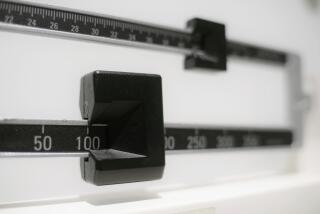Crunching the numbers
- Share via
Keeping food records and calorie counts is tedious and time-consuming -- but the often-recommended practice might be worth the trouble.
“There are some studies that show when people use some sort of monitoring of what they eat, they do better in the short term with weight loss,” says James Hill, director of the Clinical Nutrition Research Unit at the University of Colorado Health Sciences Center in Denver.
The accuracy of the calorie records doesn’t seem to matter much. “People don’t get what they eat right within even 75%,” Hill says. “I don’t think it matters how accurate people are. Simply writing down what you eat makes you more conscious of what you eat.”
Recording food intake also “brings a sense of realism,” says Gary D. Foster, clinical director of the Weight and Eating Disorders Program at the University of Pennsylvania School of Medicine. “People often feel, ‘I’ve blown it. I’m back to where I started.’ Food records keep you grounded in some real numbers.”
Although food and physical activity records are supposed to be kept daily, it isn’t necessary to record every morsel of food eaten and every French curl performed.
“If you eat the same breakfast and lunch every day, then just record your dinner and afterward,” suggests Foster. “Or just record snacks. Or maybe you just want to record on the weekends. Sort of pick your fights and look at where you are doing the most damage calorically.”
The low-tech approach -- pencil and paper -- works as well as anything else in raising awareness of what’s going into your mouth. But those who seek more precise tallies have plenty of options on the Internet that will track calories, activity, nutritional intake and, of course, your weight.
“There’s no head-to-head comparison of paper and pencil versus electronic devices” for food or exercise records, Foster says. “But it makes intuitive sense that the easier you make this, and the more feedback you can provide, the better the outcome you would expect.”
Here’s a sample of the free electronic services available. You select what you have consumed -- or what activities you’ve done -- and the website does the numbers. Some will also help you select a weight goal and graph your progress as you record food and activity:
* FitDay at www.fitday.com. Store food and exercise records on this site, which also offers the chance to post a public weight-loss journal. FitDay tracks pounds lost, shows what foods in your diet are providing the most calories, tallies what nutrients are consumed and calculates how many calories are burned working out, whether it’s walking around the block or doing crunches on a stability ball.
* Interactive Healthy Eating Index at the website 209.48.219.53. Run by the U.S. Department of Agriculture, this site can store up to 20 days of food records. A companion site -- the Physical Activity Tool -- records exercise. Both are a bit clunky to use. For example, if a serving size of fruit is half a cup and you ate a cup of raspberries, you’ll have to remember to put a “2” in the serving box. (Other programs are easier.) But that disadvantage is offset by the fact that the Healthy Eating Index relies on the massive USDA electronic food database, which has thousands of entries. This site also provides a daily “eating score” and lets you see how your intake matches up to the Food Guide Pyramid. Don’t be surprised to find that your diet is more like an hourglass than a pyramid.
* Nutridiary at www.nutridiary.com. Worried about sharing personal information before you decide if you even like electronic food logging? This site allows you to register first as a guest until your comfort level increases. Regular registration requires only minimal personal info. Nutridiary offers food information in pounds and ounces as well as metric measures. It will automatically update time zones, stores up to 10 weeks of records and allows you to download information.
* NutritionData at www.nutritiondata.com. If you love number crunching and wonder about essential nutrients, this is the site for you. An electronic “pantry” lets you look up a wide range of foods and record them. Like the USDA website, NutritionData requires a little calculating. But it also rates food according to a “fullness factor” and allows you to see better food options than the ones you may be choosing. Unlike the other sites, it also provides a nutritional analysis of recipes once ingredients are plugged in.
